
RFA Abbeydale (A109) was a fleet tanker of the Royal Fleet Auxiliary and was originally one of six ships ordered by the British Tanker Co which were purchased on the stocks by the Admiralty. She was built by Swan Hunter and Wigham Richardson Ltd and launched on 28 December 1936. Abbeydale served until being decommissioned on 18 September 1959 and laid up at HMNB Devonport. She was then sold for scrapping, arriving at the Thos. W. Ward breakers' yards at Barrow-in-Furness on 4 September 1960.

HMS Hebe was one of 21 Halcyon-class minesweepers built for the Royal Navy in the 1930s. Commissioned in 1936, Hebe served during World War II, notably taking part in the Dunkirk evacuation in 1940 and then serving in the Mediterranean, carrying out minesweeping operations from Malta. After taking part in several operations, including Operations Harpoon and Torch, and the invasion of Pantelleria, Hebe was sunk by a mine off Bari in November 1943, with the loss of 37 of the vessel's crew.
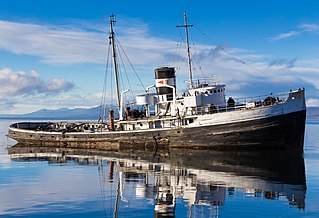
HMS Justice (W-140), a Royal Navy ship classified as a rescue tug, was built in the United States as U.S. Navy ATR-1-class rescue tugATR-20. Never commissioned into the U.S. Navy, she was transferred to the Royal Navy under Lend-Lease at delivery. Returned to the U.S. after the end of World War II, she was redesignated BATR-20. Struck and sold for commercial service in 1946, she was eventually grounded at Ushuaia, Argentina and abandoned.

HMCS Regina was a Royal Canadian Navy revised Flower-class corvette which took part in convoy escort duties during the Second World War. She fought primarily in the Battle of the Atlantic. She was named for Regina, Saskatchewan.
USS ATA-176 was an ATR-1-class rescue tug built for the United States Navy during World War II. She was laid down on 30 January 1944 and launched on 1 March as USS ATR-103, but was re-designated ATA-176 on 15 May. She was commissioned as USS ATA-176 on 19 August. She served in the U.S. Pacific Fleet during the war and was decommissioned on 30 June 1947. She was then manned with a civilian crew and placed in service, being renamed USNS Tonkawa (T-ATA-176) on 16 July 1948. Tonkawa, the first U.S. Navy vessel named for the Tonkawa, was taken out of service in 1956 and placed in reserve.
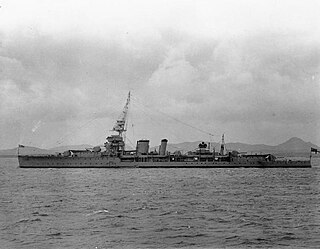
HMS Ceres was a C-class light cruiser of the Royal Navy. She was the name ship of the Ceres group of the C-class of cruisers.
HMCS Middlesex was a reciprocating engine-powered Algerine-class minesweeper built for the Royal Canadian Navy during the Second World War. Entering service in 1944, the vessel served as a convoy escort in the Battle of the Atlantic. Following the war, the ship ran aground on 2 December 1946 and broken up for scrap.
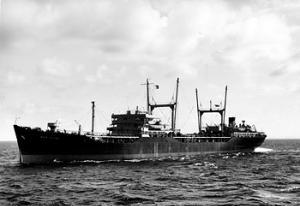
RFA Wave Victor (A220) was an 8,187 GRT Wave-class fleet support tanker of the Royal Fleet Auxiliary built at Haverton Hill-on-Tees by Furness Shipbuilding Company. She was built in 1942 as Empire Bounty for the Ministry of War Transport (MoWT). She was transferred to the Royal Fleet Auxiliary in 1946 and renamed Wave Victor with Pennant number X130. Her pennant number was later changed to A220. She served until scrapped in 1981.
USS Sotoyomo (ATR-43/ATA-121) was a rescue tug of the United States Navy that served during World War II and the early 1950s, and was sold to Mexico in 1963.
The second USS Undaunted was laid down as rescue tug ATR-126 on 27 November 1943 at Port Arthur, Texas, by the Gulfport Boiler and Welding Works; reclassified auxiliary ocean tug ATA-199 on 15 May 1944; launched on 22 August 1944; and commissioned on 20 October 1944.

HMCS Valleyfield was a River-class frigate that served with the Royal Canadian Navy during the Second World War. She served primarily as a convoy escort in the Battle of the Atlantic. She was torpedoed and sunk in May 1944, the only River-class frigate lost by the RCN. She was named for Salaberry-de-Valleyfield, Quebec.

HMS Advantage was a Favourite-class tugboat of the Royal Navy during the Second World War. Built in the United States, she was transferred to the Royal Navy under Lend-Lease. Advantage served until the end of the war with the Royal Navy and was returned to the United States postwar. Sold to a Chinese merchant shipping company, she served successively as 109, Ming 309, and Kaoshiung until her 1965 scrapping.

HMS Destiny was a Favourite-class tugboat of the Royal Navy during World War II.

HMS Eminent was a Favourite-class tugboat of the Royal Navy during World War II.
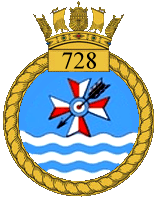
728 Naval Air Squadron was a Naval Air Squadron of the Royal Navy's Fleet Air Arm (FAA). It was formed at the beginning of May in 1943, as a Fleet Requirements Unit, at RN Air Section Gibraltar. It provided detachments at RN Air Section Tafaraoui, in Algeria and later at RAF Oujda in Morocco. Moving to HMS Grebe, RNAS Dekheila, in Egypt, during June, it then merged into 775 Naval Air Squadron during July. It reformed in August, again as a Fleet Requirements Unit, at HMS Grebe, moving immediately to RN Air Section Takali, Malta. It provided target towing both for the Royal Navy's Mediterranean Fleet and the British Army, before later providing a detachment to tow targets for the United States Navy at Naples, Italy. The squadron remained on Malta, alternating between the airbases at Ta Kali, Luqa and Hal Far, until disbanding at the latter, in May 1967.

HMS Emphatic was a Favourite-class tugboat of the Royal Navy during World War II. Emphatic was built in the United States and transferred to the Royal Navy under Lend-Lease. She participated in the Normandy landings and was returned to the United States Navy postwar. She was transferred to the Philippine Navy in 1948 and received the name Ifugao. She was stricken form the naval register in 1979.

HMS Favourite was a Favourite-class tug of the Royal Navy during World War II.
HMS Coreopsis was a Flower-class corvette, built for the Royal Navy during the Second World War which served in the Battle of the Atlantic. In 1943, she was transferred to the Royal Hellenic Navy as RHNS Kriezis and participated in the 1944 Invasion of Normandy. Shortly before she was scrapped, she took part in the British war film, The Cruel Sea.
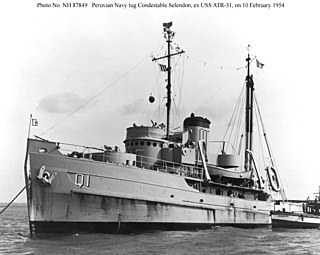
USS ATR-31 was an ATR-1-class Rescue Ocean Tug of the United States Navy during World War II, and later the Peruvian Navy. Her fate is unknown.













